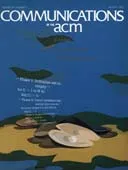August 1983 - Vol. 26 No. 8

Features
From Washington: Scientific communications and national security
The Reagan Administration has given considerable attention to the issue of “technology transfer,” by which they mean the dissemination of unclassified, but militarily sensitive U.S. technology to Eastern Bloc countries. There are some 44 separate groups in 10 or more U.S. departments either studying the subject or executing present policy, according to Louis T. Montulli, formerly of the White House Office of Science and Technology Policy.
An overview of the proposed american national standard for local distributed data interfaces
The Local Distributed Data Interface (LDDI) Project of X3 Technical Committee X3T9 has resulted in three draft proposed American National Standards for a high performance local area network. The proposed standards are organized in accordance with the ISO Reference Model for Open Systems Interconnection and encompass the lowest two protocol layers (data link and physical) of the model, plus a serial broadband coaxial bus interface. The intended application of the LDDI is as a backend network for the interconnection of high performance CPUs and block transfer peripherals such as magnetic disk and tapes. A carrier-sense multiple access with collision prevention (CSMA-CP) distributed bus arbitration protocol is employed. The cable interface supports the attachment of up to 28 ports over a cable distance of 0.5 km (8 ports may be attached to a 1 km cable) at a transfer rate of 50 Mbit/s.
Audit considerations in distributed processing systems
Applications of distributed processing networks are proliferating rapidly. It is expected that by the year 2000, distributed networks will be one of the most significant developments to evolve from the computer revolution.
Distributed networks are unique in that they bring together concepts of communication, engineering, and computing. From an audit standpoint, the complexities involved in control design and testing are challenging. The auditor needs to be knowledgeable concerning these complexities in order to apply the proper audit tools, particularly since some of these tools are in need of improvement or development. This paper provides a summary of important areas of audit concern in distributed processing systems.
A second look at bloom filters
This note deals with a paper by Gremillion demonstrating the simulation approach to the design of a Bloom filter. It is shown that an analytical approach can yield insights into competing filter design and give expected values for the goodness-of-hash transformations not available with simulation. On the other hand, simulation gives insight into what can be expected with available hash transformation not available from an analytic approach.
A generalized control structure and its formal definition
A new programming language control structure as well as an improved approach to a formal definition of programming languages are presented. The control structure can replace both iteration and conditional structures. Because it is a semantic generalization of those structures, a single statement using the new control structure can implement the functions of loops, conditionals, and also programs that would require several conventional constructs. As a consequence of this increased capability, it is possible to write algorithms that are simpler, more efficient, and more clearly correct than those that can be written with earlier structured-programming control structures. In order to provide a precise definition of the new constructs, a new version of relational semantics, called LD-relations is presented. An algebra of these relations is developed and used to define the meaning of the new constructs. A short discussion of program development and the history of control structures is included.
The economics of designing generalized software
The choice of the attributes to be incorporated in a generalized software package is a complex design task, much like the choice of the characteristics of the basic model and the options to be offered when a new automobile is being designed. Some empirical evidence available suggests that the choices made by generalized software designers are not always well founded; for example, some functions included in the software are hardly, if ever, used, while functions that would be used extensively are not available. To assist the designer, we formulate a market model showing the interactions between the producers (designers) of generalized software and the consumers (users) of generalized software. The model provides insight into those factors that affect the demand for a package and the variables to be considered in a profit-maximizing decision.
Estimation of the inverse function for random variate generation
A regression method for estimating the inverse of a continuous cumulative probability function F(x) is presented. It is assumed that an ordered sample, X1, …, Xn, of identically and independently distributed random variables is available. A reference distribution F0(x) with known inverse F0-1(p) is used to calculate the quantities Wi = i ln[F0(Xi)/F0(Xi+1)]. These quantities are used to estimate the function &ggr;(p) = pd ln≥F0[F-1(p)]⋦/dp from which an estimate of F-1(p) is derived. The method produces an estimate in a form that is convenient for random variate generation. The procedure is illustrated using data from a study of oil and gas lease bidding.
A correction to Brelaz’s modification of Brown’s coloring algorithm
Brelaz's modification of Brown's exact coloring algorithm contains two errors as demonstrated in two examples. A correct version of the algorithm and a proof of the exactness are given. Finally, Brown's look-ahead rule is built into this algorithm.



